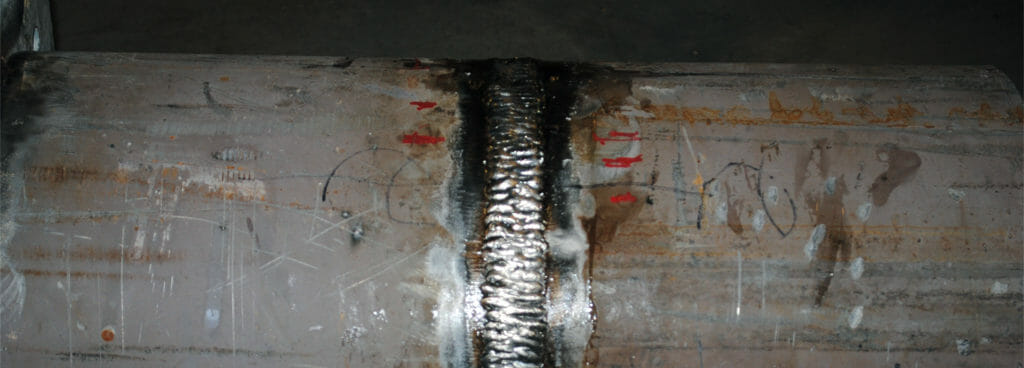The Importance of Thorough Welding Assessment in Industrial Applications
In the world of industrial applications, the importance of careful welding inspection can not be overstated. As we discover the complex advantages of diligent welding assessments, one should take into consideration the more comprehensive effects on safety, reliability, and cost-effectiveness in commercial procedures.
Enhancing Structural Stability
When it comes to welding assessment in commercial applications, enhancing structural honesty is critical. The key goal of welding examination is to guarantee that the welds are qualified of bearing the anticipated tons and stress and anxieties they will certainly come across in service.
The relevance of maintaining structural honesty in bonded frameworks can not be overemphasized. Poorly carried out welds can cause disastrous failings, resulting in costly repair services, downtime, and even endangerment of human lives. As a result, assessors play an essential function in the lifecycle of industrial parts, supplying assurance that the welding procedure delivers the preferred strength and durability.
Furthermore, progressed technologies, such as phased array ultrasonic testing and electronic radiography, offer enhanced capabilities in discovering prospective weak points, permitting rehabilitative steps before problems escalate. By prioritizing the honesty of welds with precise examination, markets can make certain operational effectiveness and extend the durability of their facilities.
Identifying Welding Problems
Determining welding issues is a crucial element of ensuring the safety and security and reliability of bonded frameworks. These problems can compromise the stability of the entire setting up and, if left unaddressed, may lead to disastrous failures. Typical welding flaws consist of porosity, splits, incomplete combination, and damaging. Each of these issues develops from certain reasons, such as inappropriate welding strategies, contamination, or insufficient heat control.

Competent inspectors utilize both aesthetic examination and progressed non-destructive testing (NDT) techniques, such as radiographic or ultrasonic testing, to find these flaws. The timely identification and correction of welding defects are important to maintain the structural honesty and longevity of industrial components.
Making Sure Conformity Requirements
Keeping the stability of bonded frameworks expands past identifying issues; it requires adherence to stringent compliance requirements. Compliance with recognized requirements, such as those provided by the American Welding Culture (AWS) and the International Organization for Standardization (ISO), guarantees that welds meet minimal safety and top quality needs. These standards include a wide variety of requirements, including material requirements, welding treatments, and credentials of welders. Adherence to these requirements is important to stop architectural failures, which can bring about devastating consequences in commercial applications.
Regular audits and assessments are essential in verifying conformity. Inspectors need to possess a detailed understanding of the pertinent requirements and be adept at using various non-destructive testing (NDT) techniques to assess weld top quality. By making certain that welding methods straighten with compliance criteria, business alleviate the threat of non-conformity, which can lead to lawful obligations and security hazards.
Furthermore, keeping conformity not just safeguards architectural integrity but also improves a firm's credibility in the industry. Customers and stakeholders are most likely to count on companies that continually show a commitment to top quality and safety and security through rigorous conformity. Thus, ensuring compliance standards is an essential part in the successful execution of welding in industrial applications.
Decreasing Upkeep Expenses

The application of sophisticated non-destructive testing (NDT) techniques, consisting of ultrasonic, radiographic, and magnetic bit examinations, improves the capacity to identify subsurface flaws without jeopardizing the structural integrity of components. By employing these strategies, markets can dramatically extend the service life of their tools, reducing downtime and the connected link monetary concern of maintenance activities.
In addition, a durable welding inspection regimen supports the optimization of maintenance routines, shifting from responsive to predictive upkeep methods. This positive strategy not only cuts unanticipated failings yet likewise streamlines source appropriation, ensuring that upkeep initiatives are concentrated and efficient. Inevitably, the financial investment in extensive welding evaluation is offset by the considerable financial savings understood with reduced maintenance demands, adding favorably to the general functional effectiveness of commercial enterprises.
Improving Safety Actions
Although safety and security is a critical concern in industrial procedures, attaining optimal safety and security requirements calls for a dedicated concentrate on the top quality and Look At This reliability of welded frameworks. Welding examination plays a critical role in this context, as it makes certain that all connections and joints meet strict safety standards. Comprehensive examinations aid identify flaws such as cracks, porosity, or incomplete blend that can jeopardize architectural stability. Such issues, if left unaddressed, posture significant threats, possibly causing devastating failings.
Approaches like ultrasonic testing, radiographic testing, and magnetic fragment examination enable for in-depth assessment without damaging the framework. Applying a durable quality control system that consists of routine training for welders and examiners makes certain adherence to established safety requirements.
Lastly, fostering a culture of safety like it and security within the organization highlights the value of comprehensive welding inspections. Motivating open communication and partnership amongst engineers, inspectors, and welders adds to a shared commitment to safety and security quality. Welding Inspection Madison. In doing so, sectors can safeguard their operations, shield employees, and keep public trust fund

Conclusion
Complete welding assessment is vital in industrial applications, dramatically boosting structural integrity and integrity. By employing advanced non-destructive testing methods, possible welding issues such as splits and incomplete blend are identified early, making sure compliance with industry criteria and fostering client trust fund. Extensive examinations cause minimized upkeep expenses and contribute to a much safer working environment. Inevitably, the attentive execution of welding examinations plays a crucial duty in preserving functional efficiency and safety and security in commercial settings.
As we explore the diverse advantages of attentive welding evaluations, one need to consider the wider effects on safety and security, reliability, and cost-effectiveness in commercial procedures.
The key goal of welding examination is to ensure that the welds are qualified of birthing the expected anxieties and loads they will certainly experience in solution. Efficient welding examination plays an indispensable role in decreasing these costs by making sure the honesty and durability of welds, thereby alleviating the danger of premature failures.Extensive welding examination is vital in industrial applications, dramatically boosting architectural stability and reliability. Ultimately, the persistent execution of welding evaluations plays an important role in keeping operational efficiency and security in industrial setups.
 Kel Mitchell Then & Now!
Kel Mitchell Then & Now! Shaun Weiss Then & Now!
Shaun Weiss Then & Now! Ben Savage Then & Now!
Ben Savage Then & Now! Molly Ringwald Then & Now!
Molly Ringwald Then & Now! Bill Cosby Then & Now!
Bill Cosby Then & Now!